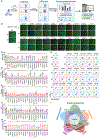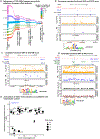Functional interrogation of twenty type 2 diabetes-associated genes using isogenic human embryonic stem cell-derived β-like cells
- PMID: 37858332
- PMCID: PMC10841752
- DOI: 10.1016/j.cmet.2023.09.013
Functional interrogation of twenty type 2 diabetes-associated genes using isogenic human embryonic stem cell-derived β-like cells
Abstract
Genetic studies have identified numerous loci associated with type 2 diabetes (T2D), but the functional roles of many loci remain unexplored. Here, we engineered isogenic knockout human embryonic stem cell lines for 20 genes associated with T2D risk. We examined the impacts of each knockout on β cell differentiation, functions, and survival. We generated gene expression and chromatin accessibility profiles on β cells derived from each knockout line. Analyses of T2D-association signals overlapping HNF4A-dependent ATAC peaks identified a likely causal variant at the FAIM2 T2D-association signal. Additionally, the integrative association analyses identified four genes (CP, RNASE1, PCSK1N, and GSTA2) associated with insulin production, and two genes (TAGLN3 and DHRS2) associated with β cell sensitivity to lipotoxicity. Finally, we leveraged deep ATAC-seq read coverage to assess allele-specific imbalance at variants heterozygous in the parental line and identified a single likely functional variant at each of 23 T2D-association signals.
Keywords: HNF4A; allelic imbalance; cellular trait; differentiation; genome-wide association studies; insulin production; lipotoxicity; single nucleotide polymorphism; β cells.
Copyright © 2023 The Author(s). Published by Elsevier Inc. All rights reserved.
Conflict of interest statement
Declaration of interests S.C. is the co-founder of OncoBeat, LLC and a consultant of Vesalius Therapeutics.
Figures






Update of
-
Functional interrogation of twenty type 2 diabetes-associated genes using isogenic hESC-derived β-like cells.bioRxiv [Preprint]. 2023 May 8:2023.05.07.539774. doi: 10.1101/2023.05.07.539774. bioRxiv. 2023. Update in: Cell Metab. 2023 Nov 7;35(11):1897-1914.e11. doi: 10.1016/j.cmet.2023.09.013. PMID: 37214922 Free PMC article. Updated. Preprint.
References
-
- Saeedi P, Petersohn I, Salpea P, Malanda B, Karuranga S, Unwin N, Colagiuri S, Guariguata L, Motala AA, Ogurtsova K, et al. (2019). Global and regional diabetes prevalence estimates for 2019 and projections for 2030 and 2045: Results from the International Diabetes Federation Diabetes Atlas, 9th edition. Diabetes Res. Clin. Pract 157, 107843. 10.1016/j.diabres.2019.107843. - DOI - PubMed
-
- Mahajan A, Spracklen CN, Zhang W, Ng MCY, Petty LE, Kitajima H, Yu GZ, Rüeger S, Speidel L, Kim YJ, et al. (2022). Multi-ancestry genetic study of type 2 diabetes highlights the power of diverse populations for discovery and translation. Nat. Genet 54, 560–572. 10.1038/s41588-022-01058-3. - DOI - PMC - PubMed
-
- Vujkovic M, Keaton JM, Lynch JA, Miller DR, Zhou J, Tcheandjieu C, Huffman JE, Assimes TL, Lorenz K, Zhu X, et al. (2020). Discovery of 318 new risk loci for type 2 diabetes and related vascular outcomes among 1.4 million participants in a multi-ancestry meta-analysis. Nat. Genet 52, 680–691. 10.1038/s41588-020-0637-y. - DOI - PMC - PubMed
Publication types
MeSH terms
Substances
Grants and funding
LinkOut - more resources
Full Text Sources
Medical
Miscellaneous

